Birotunda
| Set of cupolae | |
|---|---|
 Example: pentagonal orthobirotunda | |
| Faces | 2 n-gons 2n pentagons 4n triangles |
| Edges | 12n |
| Vertices | 6n |
| Symmetry group | Ortho: Dnh, [n,2], (*n22), order 4n Gyro: Dnd, [2n,2+ ], (2*n), order 4n |
| Rotation group | Dn, [n,2]+, (n22), order 2n |
| Properties | convex |
In
mirror reflection
of the other, while in a gyrobirotunda one rotunda is twisted relative to the other.
The pentagonal birotundas can be formed with regular faces, one a Johnson solid, the other a semiregular polyhedron:
- pentagonal orthobirotunda,
- pentagonal gyrobirotunda, which is also called an icosidodecahedron.
Other forms can be generated with
dihedral symmetry
and distorted equilateral pentagons.
Examples
| 4 | 5 | 6 | 7 | 8 |
|---|---|---|---|---|
 square orthobirotunda |
 pentagonal orthobirotunda |
 hexagonal orthobirotunda |
 heptagonal orthobirotunda |
 octagonal orthobirotunda |
 square gyrobirotunda |
 pentagonal gyrobirotunda (icosidodecahedron) |
 hexagonal gyrobirotunda |
 heptagonal gyrobirotunda |
 octagonal gyrobirotunda |
See also
- Gyroelongated pentagonal birotunda
- Elongated pentagonal orthobirotunda
- Elongated pentagonal gyrobirotunda
References
- Norman W. Johnson, "Convex Solids with Regular Faces", Canadian Journal of Mathematics, 18, 1966, pages 169–200. Contains the original enumeration of the 92 solids and the conjecture that there are no others.
- Victor A. Zalgaller (1969). Convex Polyhedra with Regular Faces. Consultants Bureau. No ISBN. The first proof that there are only 92 Johnson solids.
